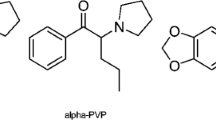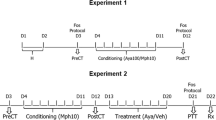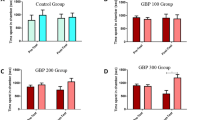Abstract
Rationale
Topiramate is an anticonvulsant drug which has been evaluated as a therapeutic option for the treatment of cocaine addiction during the last decade.
Objectives
The purpose of this study was to evaluate the effects of topiramate on the reinforcing actions of cocaine. To this aim, the topiramate-mediated regulation of acquisition and extinction phases of the cocaine conditioned place preference (CPP) was assessed in young-adult mice using three experimental designs.
Methods
Topiramate (50 mg/kg, p.o.) was given as follows: (1) during cocaine (1 and 25 mg/kg, i.p.) conditioning sessions (4 days) and cocaine (25 mg/kg) post-conditioning session; (2) 2 weeks before and during cocaine conditioning (25 mg/kg); and (3) during extinction of CPP induced by cocaine (25 mg/kg). In the first experimental design, changes in tyrosine hydroxylase (TH) and dopamine transporter (DAT) gene expressions were measured in the ventral tegmental area (VTA).
Results
Topiramate significantly increased cocaine-induced CPP and delayed or failed to produce extinction after the first cocaine reinstatement extinction in the first and second experiments. Furthermore, treatment with topiramate after place conditioning blocked the extinction of cocaine-induced CPP. TH and DAT gene expression in the VTA was significantly lower both with topiramate alone and in combination with cocaine compared with animals receiving only cocaine.
Conclusions
These findings suggest that topiramate increases the rewarding properties of cocaine, at least in part, by regulating dopaminergic signaling in the mesolimbic circuit. Consequently, the results of this study do not support the use of topiramate for the treatment of problems related to cocaine dependence.
Highlights
• Topiramate increases the rewarding properties of cocaine in CPP
• Topiramate alters dopaminergic signaling in the mesolimbic circuit
• Topiramate delays the extinction of cocaine-induced CPP
• TH and DAT gene expression in the VTA decreases with topiramate and/or with cocaine
• Results show that it should limit the use of topiramate in cocaine-dependent subjects





Similar content being viewed by others
References
Aguilar MA, Rodríguez-Arias M, Miñarro J (2009) Neurobiological mechanisms of the reinstatement of drug-conditioned place preference. Brain Res Rev 59:253–277. doi:10.1016/j.brainresrev.2008.08.002
Aracil-Fernández A, Almela P, Manzanares J (2013) Pregabalin and topiramate regulate behavioural and brain gene transcription changes induced by spontaneous cannabinoid withdrawal in mice. Addict Biol 18:252–262. doi:10.1111/j.1369-1600.2011.00406.x
Arenas MC, Daza-Losada M, Vidal-Infer A, Aguilar MA, Miñarro J, Rodríguez-Arias M (2014) Capacity of novelty-induced locomotor activity and the hole-board test to predict sensitivity to the conditioned rewarding effects of cocaine. Physiol Behav 133:152–160. doi:10.1016/j.physbeh.2014.05.028
Balda MA, Anderson KL, Itzhak Y (2009) The neuronal nitric oxide synthase (nNOS) gene contributes to the regulation of tyrosine hydroxylase (TH) by cocaine. Neurosci Lett 457:120–124
Belin D, Deroche-Gamonet V, Jaber M (2007) Cocaine-induced sensitization is associated with altered dynamics of transcriptional responses of the dopamine transporter, tyrosine hydroxylase, and dopamine D2 receptors in C57Bl/6 J mice. Psychopharmacology 193:567–578
Blaze MP (2015) Topiramate in Stimulant Use Disorder: Is Topiramate All it’s Cracked Up to Be? Review. Division of Pharmacotherapy, The University of Texas. https://www.utexas.edu/pharmacy/divisions/pharmaco/rounds/blaze04-09-15.pdf
Braga MF, Aroniadou-Anderjaska V, Li H, Rogawski MA (2009) Topiramate reduces excitability in the basolateral amygdala by selectively inhibiting GluK1 (GluR5) kainate receptors on interneurons and positively modulating GABAA receptors on principal neurons. J Pharmacol Exp Ther 330:558–566
Darland T, Mauch JT, Meier EM, Hagan SJ, Dowling JE, Darland DC (2012) Sulpiride, but not SCH23390, modifies cocaine-induced conditioned place preference and expression of tyrosine hydroxylase and elongation factor 1alpha in zebrafish. Pharmacol Biochem Behav 103:157–167
Echeverry-Alzate V, Giné E, Bühler KM, Calleja-Conde J, Olmos P, Gorriti MA, et al. (2014) Effects of topiramate on ethanol-cocaine interactions and DNA methyltransferase gene expression in the rat prefrontal cortex. Br J Pharmacol 171:3023–3036. doi:10.1111/bph.12636
European Monitoring Centre for Drugs and Drug Addiction (2007) EMCDDA Literature reviews — Treatment of problem cocaine use: a review of the literature. Lisbon: European Monitoring Centre for Drugs and Drug Addiction. ISBN: 92–9168–274-8.
Gasior M, Ungard JT, Witkin JM (1999) Preclinical evaluation of newly approved and potential antiepileptic drugs against cocaine-induced seizures. J Pharmacol Exp Ther 290:1148–1156
Gass JT, Olive MF (2008) Glutamatergic substrates of drug addiction and alcoholism. Biochem Pharmacol 75:218–265
Johnson BA (2004) Topiramate-induced neuromodulation of cortico-mesolimbic dopamine function: a new vista for the treatment of comorbid alcohol and nicotine dependence? Addict Behav 29:1465–1479. doi:10.1016/j.addbeh.2004.06.014
Johnson BA (2005) Recent advances in the development of treatments for alcohol and cocaine dependence: focus on topiramate and other modulators of GABA or glutamate function. CNS Drugs 19:873–896. doi:10.2165/00023210-200519100-00005
Johnson BA, Roache JD, Ait-Daoud N, Wells LT, Wallace CL, Dawes MA, et al. (2007) Effects of acute topiramate dosing on methamphetamine-induced subjective mood. Int J Neuropsychopharmacol 10:85–98
Johnson BA, Ait-Daoud N, Wang XQ, Penberthy JK, Javors MA, Seneviratne C, et al. (2013a) Topiramate for the treatment of cocaine addiction: a randomized clinical trial. JAMA Psychiatry 70:1338–1346. doi:10.1001/jamapsychiatry.2013.2295
Johnson BA, Roache JD, Ait-Daoud N, Gunderson EW, Haughey HM, Wang XQ, et al. (2013b) Topiramate’s effects on cocaine-induced subjective mood, craving and preference for money over drug taking. Addict Biol 18:405–416. doi:10.1111/j.1369-1600.2012.00499.x
Kampman KM, Patinas H, Lynch KG, Dackis C, Sparkman T, Weigley C, et al. (2004) A pilot trial of topiramate for the treatment of cocaine dependence. Drug Alcohol Depend 75:233–240
Kampman KM, Pettinati HM, Lynch KG, Spratt K, Wierzbicki MR, O’Brien CP (2013) A double-blind, placebo-controlled trial of topiramate for the treatment of comorbid cocaine and alcohol dependence. Drug Alcohol Depend 133:94–99. doi:10.1016/j.drugalcdep.2013.05.026
Karila L, Gorelick D, Weinstein A, Noble F, Benyamina A, Coscas S, et al. (2008) New treatments for cocaine dependence: a focused review. Int J Neuropsychopharmacol 11:425–438
Kim JH, Lawrence AJ (2014) Drugs currently in Phase II clinical trials for cocaine addiction. Expert Opin Investig Drugs 23:1105–1122. doi:10.1517/13543784.2014.915312
Le Foll B, Justinova Z, Wertheim CE, Barnes C, Goldberg SR (2008) Topiramate does not alter nicotine or cocaine discrimination in rats. Behav Pharmacol 19:13–20. doi:10.1097/FBP.0b013e3282f3cf84
Lin SK (2013) Pharmacological means of reducing human drug dependence: a selective and narrative review of the clinical literature. Br J Clin Pharmacol 77:242–252. doi:10.1111/bcp.12163
Livak KJ, Schmittgen TD (2001) Analysis of relative gene expression data using real-time quantitative PCR and the 2(-Delta Delta C(T)). Methods 25:402–408
Maldonado C, Rodríguez-Arias M, Castillo A, Aguilar MA, Miñarro J (2006) Gamma-hydroxybutyric acid affects the acquisition and reinstatement of cocaine-induced conditioned place preference in mice. Behav Pharmacol 17:119–131
Manzanedo C, Aguilar MA, Rodríguez-Arias M, Miñarro J (2001) Effects of dopamine antagonists with different receptor blockade profiles on morphine-induced place preference in male mice. Behav Brain Res 121:189–197
Manzanedo C, García-Pardo MP, Rodríguez-Arias M, Miñarro J, Aguilar MA (2012) Pre-treatment with high doses of cocaine decreases the reinforcing effects of cocaine in the conditioned place preference paradigm. Neurosci Lett 516:29–33. doi:10.1016/j.neulet.2012.03.044
Mateos-García A, Roger-Sánchez C, Rodriguez-Arias M, Miñarro J, Aguilar MA, Manzanedo C, et al. (2015) Higher sensitivity to the conditioned rewarding effects of cocaine and MDMA in High-Novelty-Seekers mice exposed to a cocaine binge during adolescence. Psychopharmacology 232:101–113. doi:10.1007/s00213-014-3642-y
Minozzi S, Cinquini M, Amato L, Davoli M, Farrell MF, Pani PP, et al. (2015) Anticonvulsants for cocaine dependence. Cochrane Database Syst Rev 17(4):CD006754. doi:10.1002/14651858.CD006754.pub4
Montagud-Romero S, Daza-Losada M, Vidal-Infer A, Maldonado C, Aguilar MA, Miñarro J (2014) The novelty-seeking phenotype modulates the long-lasting effects of intermittent ethanol administration during adolescence. PLoS One 9:e92576. doi:10.1371/journal.pone.0092576 eCollection 2014
Moore CF, Lycas MD, Bond CW, Johnson BA, Lynch WJ (2014) Acute and chronic administration of a low-dose combination of topiramate and ondansetron reduces ethanol’s reinforcing effects in male alcohol preferring (P) rats. Exp Clin Psychopharmacol 22:35–42. doi:10.1037/a0035215
Navarrete F, Pérez-Ortiz JM, Manzanares J (2012a) Pregabalin- and topiramate-mediated regulation of cognitive and motor impulsivity in DBA/2 mice. Br J Pharmacol 167:183–195. doi:10.1111/j.1476-5381.2012.01981.x
Navarrete F, Pérez-Ortiz JM, Manzanares J (2012b) Cannabinoid CB2 receptor-mediated regulation of impulsive-like behaviour in DBA/2 mice. Br J Pharmacol 165:260–273. doi:10.1111/j.1476-5381.2011.01542.x
Nuijten M, Blanken P, van den Brink W, Hendriks V (2014) Treatment of crack-cocaine dependence with topiramate: a randomized controlled feasibility trial in The Netherlands. Drug Alcohol Depend 138:177–184. doi:10.1016/j.drugalcdep.2014.02.024
Reid MS, Palamar J, Raghavan S, Flammino F (2007) Effects of topiramate on cue-induced cigarette craving and the response to a smoked cigarette in briefly abstinent smokers. Psychopharmacology 192:147–158
Reis AD, Castro LA, Faria R, Laranjeira R (2008) Craving decrease with topiramate in outpatient treatment for cocaine dependence: an open label trial. Rev Bras Psiquiatr 30:132–135
Rodriguez-Arias M, Montagud-Romero S, Rubio-Araiz A, Aguilar MA, Martín-García E, Cabrera R, Maldonado R, Porcu F, Colado MI, Miñarro J (2015) Effects of repeated social defeat on adolescent mice on cocaine-induced CPP and self-administration in adulthood: integrity of the blood–brain barrier. Addict Biol. doi:10.1111/adb.12301
Tatsuta T, Kitanaka N, Kitanaka J, Morita Y, Takemura M (2007) Lack of effect of anticonvulsant topiramate on methamphetamine-induced stereotypy and rewarding property in mice. Pharmacol Biochem Behav 87:48–55. doi:10.1016/j.pbb.2007.03.019
Tzschentke TM (2007) Measuring reward with the conditioned place preference (CPP) paradigm: update of the last decade. Addict Biol 12:227–462
Umbricht A, DeFulio A, Winstanley EL, Tompkins DA, Peirce J, Mintzer MZ, et al. (2014) Topiramate for cocaine dependence during methadone maintenance treatment: a randomized controlled trial. Drug Alcohol Depend 140:92–100. doi:10.1016/j.drugalcdep.2014.03.033
United Nations Office on Drugs and Crime, World Drug Report (2014) United Nations publication, Sales No. E.14.XI.7. http://www.unodc.org/documents/data-andanalysis/WDR2014/World_Drug_Report_2014_web.pdf
Vidal-Infer A, Arenas MC, Daza-Losada M, Aguilar MA, Miñarro J, Rodríguez-Arias M (2012) High novelty-seeking predicts greater sensitivity to the conditioned rewarding effects of cocaine. Pharmacol Biochem Behav 102:124–132. doi:10.1016/j.pbb.2012.03.031
Acknowledgments
We wish to thank to Ana Díaz PhD, responsible for the welfare of experimental animals in our university, to INVASSAT, particularly Teresa Capilla, for laboratory equipment, and Brian Normanly for his editing of the manuscript. This work was supported by the following research grants: Ministerio de Economía y Competitividad, Dirección General de Investigación, PSI2014-51847-R (José Miñarro) and SAF2011-23420 (Jorge Manzanares). Instituto de Salud Carlos III, Redes Temáticas de Investigación Cooperativa en Salud (RECTICS), Red de Trastornos Adictivos (RTA) RD12/0028/0005 (José Miñarro), RD12/0028/0019 (Jorge Manzanares) and Fondos FEDER. Generalitat Valenciana, Conselleria de Educación, PROMETEOII/2014/063.
Author information
Authors and Affiliations
Corresponding author
Ethics declarations
Conflict of ethical standards
The authors declare that they have no conflict of interest.
Rights and permissions
About this article
Cite this article
Arenas, M.C., Mateos-García, A., Manzanedo, C. et al. Topiramate increases the rewarding properties of cocaine in young-adult mice limiting its clinical usefulness. Psychopharmacology 233, 3849–3859 (2016). https://doi.org/10.1007/s00213-016-4409-4
Received:
Accepted:
Published:
Issue Date:
DOI: https://doi.org/10.1007/s00213-016-4409-4




